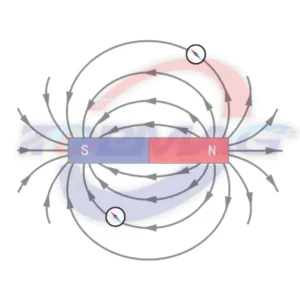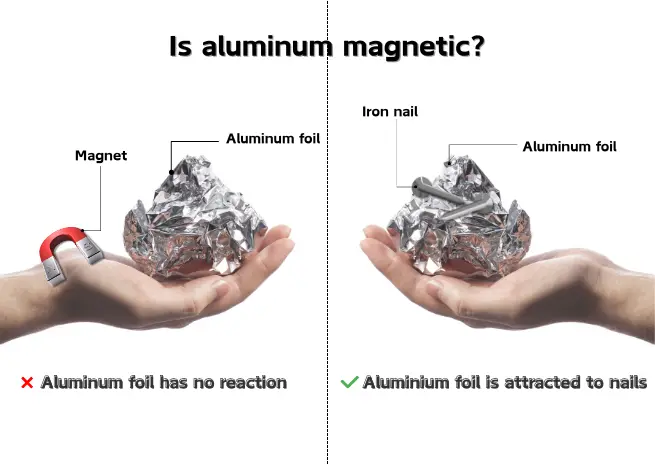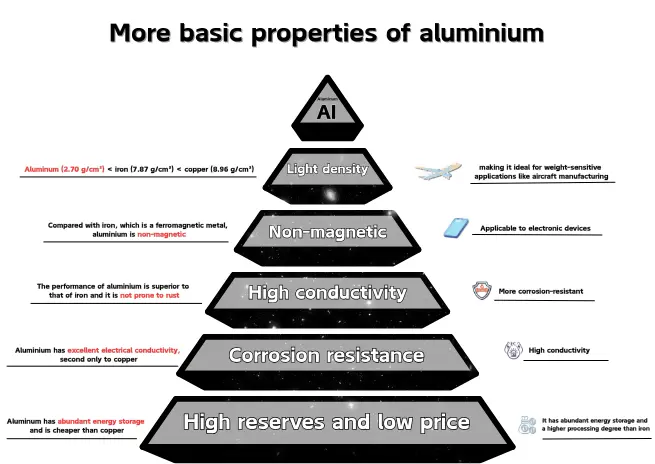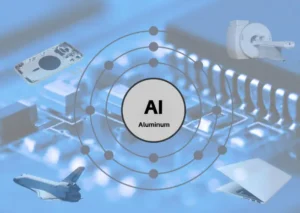Why Aluminum Lacks Magnetism: Properties and Practical Implications

Magnetism refers to the ability of certain substances to generate an invisible magnetic field that can attract or repel other substances. The attraction or repulsion between magnetic materials happens through this fascinating magnetic field. The magnetic field is like an “invisible web” surrounding magnetic poles, influencing nearby objects. The Earth itself is like a giant magnet!
Magnetism is divided into three types:
Diamagnetism: Materials like water or wood are slightly pushed away in a magnetic field, but this effect is so weak that it’s barely noticeable in everyday life.
Paramagnetism: Materials like aluminum are faintly attracted to a magnetic field, but their magnetism is weak and disappears as soon as the field is gone.
Ferromagnetism: Materials like iron, nickel, or cobalt are strongly attracted to magnets and can even retain their magnetism after the magnetic field is removed.
Aluminum is the most common metal globally. It is light in weight, not susceptible to rust, and widely used in everything from airplane fuselages to kitchen foil. However, were you to ask whether aluminum can be attracted by a magnet like iron? Why certain materials are magnetic and some are not? Let’s dive into the science and unravel the mystery of aluminum and magnetism step by step.
Is aluminum magnetic?
Aluminum is a common metal in our daily lives, but have you ever wondered if magnets can attract it? The answer is that aluminum is almost non-magnetic!
At the microscopic level, aluminum atoms have 13 electrons arranged in a specific pattern. The outermost electrons determine aluminum’s magnetic properties. These electrons produce a weak response in an external magnetic field, known as paramagnetism. However, aluminum’s paramagnetism is so weak that it’s practically negligible, far from enough to be attracted by a magnet.
Let’s look at aluminum’s crystal structure. Its atoms are arranged in a highly organized pattern called a face-centered cubic structure. This structure is very stable but “powerless” when it comes to magnetism. It doesn’t support the formation of magnetic domains, so it cannot create a unified magnetic field like iron does.
We can verify this with a simple experiment: take a magnet, a piece of aluminum foil, and an iron nail. Move the magnet close to the aluminum foil, and it won’t budge. But bring it near the iron nail, and the nail will be firmly attracted. This experiment clearly demonstrates aluminum’s non-magnetic nature.

More basic properties of aluminium
- Density: Aluminum (2.70 g/cm³) is much lighter than iron (7.87 g/cm³) and copper (8.96 g/cm³), making it ideal for weight-sensitive applications like aircraft manufacturing.
- Magnetism: Iron is a ferromagnetic metal, while copper and aluminium are non-magnetic and are suitable for electronic devices.
- Corrosion Resistance: Aluminum and copper outperform iron, which rusts easily unless made into stainless steel.
- Conductivity: Copper has the best electrical conductivity, followed by aluminium, with iron lagging behind.
- Cost and Abundance: Aluminum is abundant and cheaper than copper, though its processing costs are higher than iron’s.

Applications of Aluminum

Besides that, aluminium is extensively used in different branches of industry. In MRI systems, aluminium-made parts are not changed by large magnetic fields, and accuracy concerning the image is ensured. In aerospace, the factors that make aluminium great are its low density and non-magnetism perfect qualities of that make up the aeroplane fuselage, the weight of the plane is reduced, and the magnetic field interference with the navigation systems is eliminated.
Summary
Aluminium is non-magnetic, a property determined by its atomic structure and crystal characteristics. For this property, you can say that its atomic structure and crystal characteristics are its determining factors. In the years to come, when recycling techniques get more advanced, we will witness aluminium taking even more pivotal positions in the green economy.

I'm dedicated to popular science writing about magnets. My articles mainly focus on their principles, applications, and industry anecdotes. Our goal is to provide readers with valuable information, helping everyone better understand the charm and significance of magnets. At the same time, we're eager to hear your opinions on magnet-related needs. Feel free to follow and engage with us as we explore the endless possibilities of magnets together!



